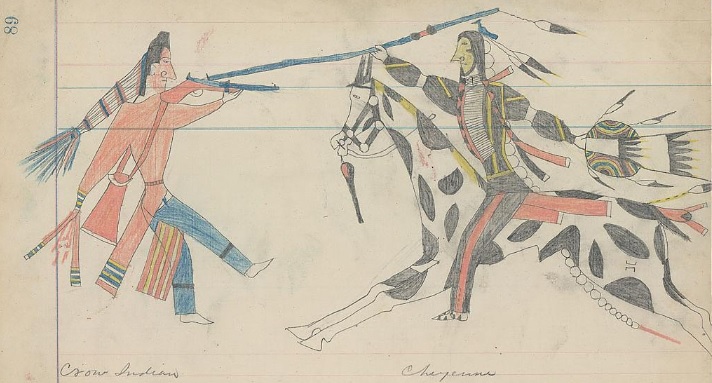counting coup on:
[Wikipedia]
[Google]
[Amazon]
 Among the Plains Indians of
Among the Plains Indians of
/ref>
''Antiques Roadshow'', WGBH. Touching the first enemy to die in battle or touching the enemy's defensive works was also considered counting coup, as was, in some nations, simply riding up to an enemy, touching him with a short stick, and riding away unscathed.Mercedes Mejía
"Campfire Stories: 'Counting coup' and a warrior's unbreakable pride"
(text introduction to a broadcast story from Potawatomi elder Colin Wesaw), Michigan Public Radio, 14 August 2018. Counting coup has at times also involved stealing an enemy's weapons or horses tied up to his lodge in camp. Risk of injury or death is traditionally required to count coup."COUNTING COUP"
''Encyclopedia of the Great Plains Indians''. University of Nebraska–Lincoln, 2011. Escaping unharmed while counting coup is traditionally considered a higher honor than being wounded in the attempt. After a battle or exploit, the people of a band gathered to recount their acts of bravery. Coups have been recorded by putting notches in a coup stick. Indigenous peoples of the
Plenty Coups and Linderman, Frank Bird. ''Plenty-Coups, Chief of the Crows.'' Lincoln, Neb.: University of Nebraska Press, 2002.
{{DEFAULTSORT:Counting Coup Indigenous culture of the Great Plains Military history of Native Americans Warrior code
 Among the Plains Indians of
Among the Plains Indians of North America
North America is a continent in the Northern Hemisphere, Northern and Western Hemisphere, Western hemispheres. North America is bordered to the north by the Arctic Ocean, to the east by the Atlantic Ocean, to the southeast by South Ameri ...
, counting coup () (“coup“ is french for “blow” or “shock”) is the warrior
A warrior is a guardian specializing in combat or warfare, especially within the context of a tribal society, tribal or clan-based warrior culture society that recognizes a separate warrior aristocracy, social class, class, or caste.
History
...
tradition of winning prestige against an enemy in battle. It is one of the traditional ways of showing bravery in the face of an enemy and involves intimidating him, and, it is hoped, persuading him to admit defeat, without having to kill him. These victories may then be remembered, recorded, and recounted as part of the community's oral, written, or pictorial histories.
Historical precedents
Historically, any blow struck against the enemy counted as a coup, but the most prestigious acts included touching an enemy warrior with a hand, bow, or coup stick and escaping unharmed, and without harming the enemy, except for the enemy's wounded pride.Plenty Coups and Linderman, ''Plenty-Coups, Chief of the Crows'', 2002, p. 31./ref>
''Antiques Roadshow'', WGBH. Touching the first enemy to die in battle or touching the enemy's defensive works was also considered counting coup, as was, in some nations, simply riding up to an enemy, touching him with a short stick, and riding away unscathed.Mercedes Mejía
"Campfire Stories: 'Counting coup' and a warrior's unbreakable pride"
(text introduction to a broadcast story from Potawatomi elder Colin Wesaw), Michigan Public Radio, 14 August 2018. Counting coup has at times also involved stealing an enemy's weapons or horses tied up to his lodge in camp. Risk of injury or death is traditionally required to count coup."COUNTING COUP"
''Encyclopedia of the Great Plains Indians''. University of Nebraska–Lincoln, 2011. Escaping unharmed while counting coup is traditionally considered a higher honor than being wounded in the attempt. After a battle or exploit, the people of a band gathered to recount their acts of bravery. Coups have been recorded by putting notches in a coup stick. Indigenous peoples of the
Pacific Northwest
The Pacific Northwest (PNW; ) is a geographic region in Western North America bounded by its coastal waters of the Pacific Ocean to the west and, loosely, by the Rocky Mountains to the east. Though no official boundary exists, the most common ...
traditionally tied an eagle feather to their coup sticks for each coup counted. Among the Blackfoot nation of the upper Missouri River Valley, coup was recorded by the placement of "coup bars" on the sleeves and shoulders of special shirts bearing paintings of the warrior's exploits in battle. Many shirts of this sort have survived to the present, including some in European museums.Brownstone, Arni. "The Musée de l'Homme's Foureau Robe and Its Moment in the History of Blackfoot Painting". ''Plains Anthropologist'' 46.177 (2001): 249–267: 255. . In some tribes, a warrior who won coup was permitted to wear an eagle feather in his hair, and if wounded in the attempt, was required to paint the feather red to indicate this.
Contemporary accounts
Joe Medicine Crow (1913–2016) is credited with achieving the feat while serving with the US Army duringWorld War II
World War II or the Second World War (1 September 1939 – 2 September 1945) was a World war, global conflict between two coalitions: the Allies of World War II, Allies and the Axis powers. World War II by country, Nearly all of the wo ...
, as on one occasion he overpowered and disarmed a German soldier, and later stole horses from an SS unit.
References
Bibliography
Plenty Coups and Linderman, Frank Bird. ''Plenty-Coups, Chief of the Crows.'' Lincoln, Neb.: University of Nebraska Press, 2002.
{{DEFAULTSORT:Counting Coup Indigenous culture of the Great Plains Military history of Native Americans Warrior code